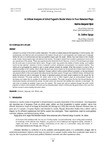| dc.description.abstract | Literature is a product of the writer’s artistic imagination. The writer accurately observes the happenings in his/her society, both contemporary, and historical and communicates to the reader s through use of vivid imagination and creative use of language. His/her her aim is to communicate and have an aesthetic impact upon t he reader. Writers, thus fuse history in their creative works. Indeed, literature gets shape and direction from society. The shape is derived fr om society’s experiences in terms of the raw experiences of the society. These raw experiences also dictate the kind of literature; in terms of the techniques and style s that the writer uses to communicate his/ her vision. Though a writer may present the realities of his/her society, such realities cannot be fully objective. Literature is fiction; it presents a writer’s perspective and perception of a society’s realities. Thus writers aim at persuading the readers to take a certain attitude to wards the realities. What they present is a slice of life; a selected paradigm of the realities. South African literature was mainly shaped by the experiences of black South African; the experiences arising out of the system of Apartheid. However different writers present different perception on the psychological and physical effects of this racist system that dehumanized t he black people. Through use of different literary techniques and styles the writers are able to interrogate the ideals of Apartheid system and make artistic judgment on t he values that the system entranced. This study examines the artistic vision in four of Athol Fugard’s plays as communicated through the techniques and styles that he employs for aesthetic communication. The study recognizes the fact that though literature is indeed given impetus and direction by society, the artist cannot just document that realities like a historian or sociologist. The artist aims at creating an aesthetic impact upon the readers. This impact can only be achieved through the writer’ artistic judgment on what is communicated. Elements such as characterization, choice of diction and the general tone of the work thus become crucial in communicating the writer’s vision. | en_US |

